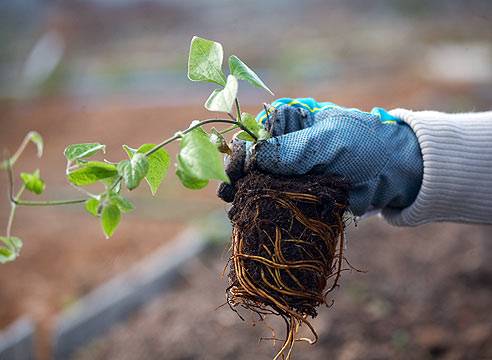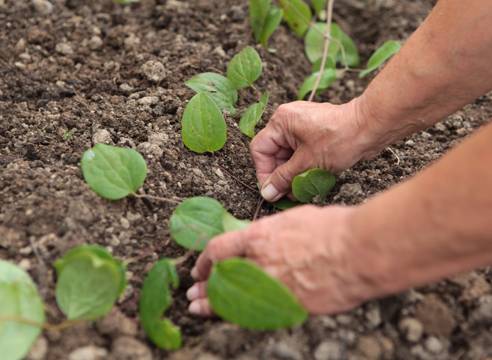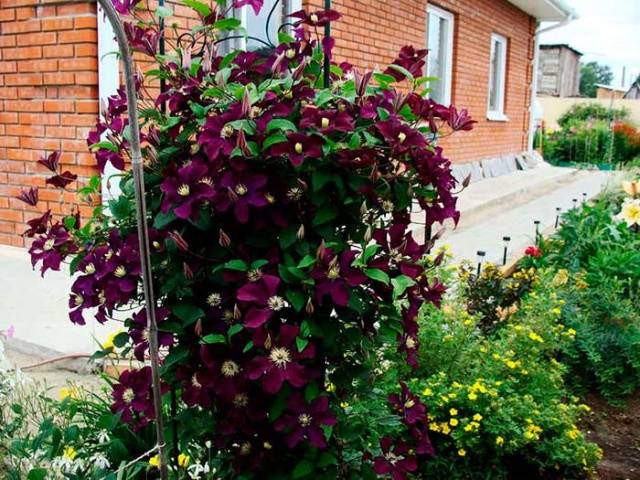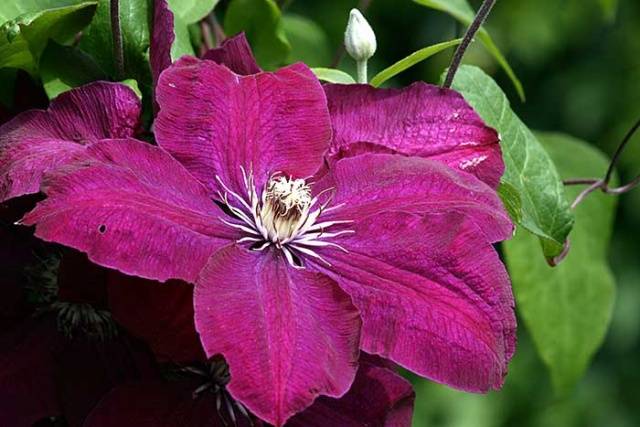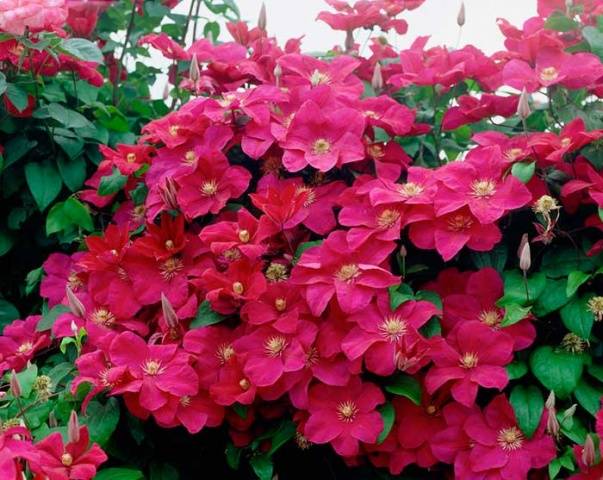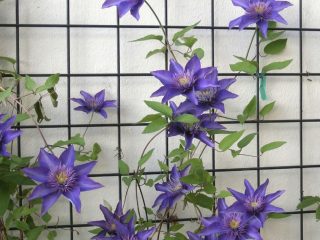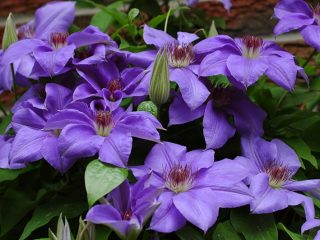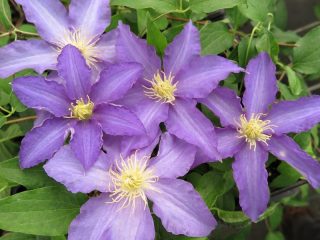Content
Clematis is a favorite flower of landscape designers. The plant is popular among amateur gardeners. Among the popular varieties, clematis large-flowered caper Rouge Cardinal stands out for its magnificent forms, the description of which we will now consider.
French breeders developed hybrid clematis Rouge Cardinal. Decorative climbing vine with large flowers grows up to 3 m in height. The color of young shoots is light green. The leaves are medium sized, complex trifoliate in shape. The color of the leaf blade is dark green. One vine leaf consists of several small leaves. The front surface of the leaf blade is leathery.
The clematis root is powerful and goes deep into the ground. Flowers appear on new shoots. The flowering period is considered late and lasts from early July to September. The liana is densely covered with velvety large flowers with dark purple petals. The shape of the inflorescences is cross-shaped. The diameter of a blooming flower can reach 15 cm.
The Cardinal variety liana is very tenacious. The plant grabs onto any object, secures itself and continues to stretch further upward.If a clematis whip gets caught on a tree, it will completely cover it during the season.
Considering clematis Rouge Cardinal, description, photos, reviews, it is worth noting that the plant is not capricious in terms of care. The variety is rarely affected by pests and pathogens. Liana withstands cold winters.
Features of growing vines
Any garden plant, even if it is unpretentious, requires compliance with the rules of care. Continuing the review of clematis Rouge Cardinal, photo and description of the variety, it is worth familiarizing yourself in detail with the conditions of agricultural technology of the crop.
Sowing seeds
To grow clematis Rouge Cardinal from seedlings, you need to visit a flower shop. The plant can be sold in a plastic pot with or without fertilized substrate. A bare root seedling is not the best option. It is optimal to grow a flower from seeds, which is what most gardeners do.
If you decide to grow clematis large-flowered caper Rouge Cardinal at home, first prepare the site. Under one flower, dig a hole with a depth and a diameter of 60 cm. A drainage layer 15 cm thick of small stones or broken bricks is poured onto the bottom. Half of the remaining volume of the hole is filled with humus. Any rotted manure or leaf compost will do. The remainder of the free volume of the hole is filled with fertile soil. The pit is prepared at least a month before planting. During this time, the earth will settle, beneficial microorganisms will appear, and earthworms will mix the humus with the soil.
Gardeners determine the timing of sowing Cardinal by the size of the seeds. Large grains are strong. Seeds are sown in late autumn before winter.To ensure reliable seedlings, grains can be stratified for three months at a temperature of +5OC and sow in spring.
Small grains in the ground may not survive the winter. Such seeds are sown only in spring. The best months are March and April. Sow Cardinal grains in open ground or place a small greenhouse to speed up germination.
Before planting seedlings grown from seeds or purchased, a trellis is installed near the prepared holes. The height of the supports above the ground should be at least 2 m. If the vine grows near the house, then the planting hole should be at least 20 cm away from the wall. The trellis is placed at a distance of 10 cm from the hole.
If a seedling of the Cardinal variety is grown from seeds in a cup, then planting in a permanent place is carried out according to the following rules:
- They begin to prepare the seedling for planting by examining the roots. If for some reason the root system is dry, it is soaked in cold water.
- Part of the fertile soil is removed from the previously prepared hole. At the bottom, form a mound from the soil, lightly compacting it with your hands.
- A seedling is placed on a hill. The root system is straightened along the slopes of the mound. If a seedling is removed from a cup with a whole lump of earth, then in this state it is placed on the bottom of the hole.
- Backfilling of the root system is carried out with fertile soil extracted from the hole. Moreover, the root collar and part of the stem of the seedling are covered.
- At the end of planting, the plant is watered generously with water at room temperature.
When planting several clematis nearby, a minimum distance of 1.5 m is maintained between the seedlings. During the summer season, the growth of the vine is monitored. If clematis grandiflora Rouge Cardinal is oppressed and produces little growth, it means that the place is not suitable for the plant. The problem can only be solved by transplanting the vine to another area next spring.
Features of liana care
For the gardener planting clematis Rouge Cardinal and caring for the plant will not cause much trouble. The liana is watered, and quite often. Clematis loves moisture very much. Since the root system grows far into the depths of the earth, a lot of water is poured under the plant. After watering, loosen the soil. Weed periodically weeds.
Clematis varieties Cardinal love frequent feeding. For the splendor of flowers and the formation of a large number of new inflorescences, fertilizers are applied twice a month. The type of feeding of the vine depends on the season:
- When shoots begin to grow on clematis in the spring, the vine requires nitrogen. The flower is fed with ammonium nitrate. For organic matter, use a solution of bird droppings or mullein.
- With the beginning of the appearance of buds, organic matter is combined with mineral complexes.
- In summer, during flowering, clematis variety Cardinal is watered with a pink solution of manganese. You can dilute a weak solution of boric acid.
- By the end of August, shoots on clematis should begin to ripen. To speed up the process, the vine is fed with stimulating mineral complexes. Fertilizing with wood ash helps flower shoots ripen faster.
- In the fall, before preparing for wintering, the soil under the clematis is dug up with the addition of potassium sulfate.
All types of flower fertilizers are usually introduced simultaneously with abundant watering, so that beneficial microelements can penetrate deep into the ground to the root system.
Pruning for winter
For clematis Rouge Cardinal, pruning for the winter is absolutely necessary, and the procedure is performed after flowering has ended. How much the vine needs to be shortened depends on its membership in the group:
- The first group of clematis is not pruned for the winter. The liana remains to spend the winter on the trellis and mounts high in late autumn. Immediately after flowering, damaged and dry shoots are cut off, and the bush is thinned out if it is very thick. The first group includes clematis with small flowers.
- At the end of flowering, the second group of clematis is cut off to half its height. Usually, a part of the vine about 1.5 m high is left above the ground. The second group includes clematis, which bloom in early spring. A large number of flowers appear on the trimmed lashes. There are usually few inflorescences on new shoots.
- Clematis of the third group are completely pruned in the fall. Stems with two to three pairs of buds are left above the ground. The height of the protruding shoots should not exceed 20 cm. After pruning, hilling is carried out immediately. Clematis of the third group are distinguished by their abundant color and low maintenance requirements.
For clematis Rouge Cardinal, the third pruning group is suitable. After hilling up the remaining shoots of the vine, they are covered with dry leaves. Pine branches are laid on top. If there is a shortage of organic shelter, cover the flower with film or agrofibre.
In the video, clematis “Rouge Cardinal” and “Justa”:
Diseases and pests
The Rouge Cardinal variety is resistant to diseases, but gardeners cannot relax.Lianas need preventive treatments against powdery mildew, rust, and damage by putrefactive bacteria. Wilt poses a great danger to the Rouge Cardinal variety. The affected vine begins to wither and dries quickly. At the first symptoms, you should not feel sorry for the bush. Clematis cannot be cured. The liana is dug up and burned.
The best prevention for lianas is treatment with fungicides. Of the drugs, Quadris and Horus have proven themselves well. Not a bad fungicide. During drought, the second threat to clematis is the spider mite. Insecticides are used to control the pest.
Reviews
Gardeners leave reviews about clematis Rouge Cardinal on many forums, and they often help beginners find answers to their questions.


